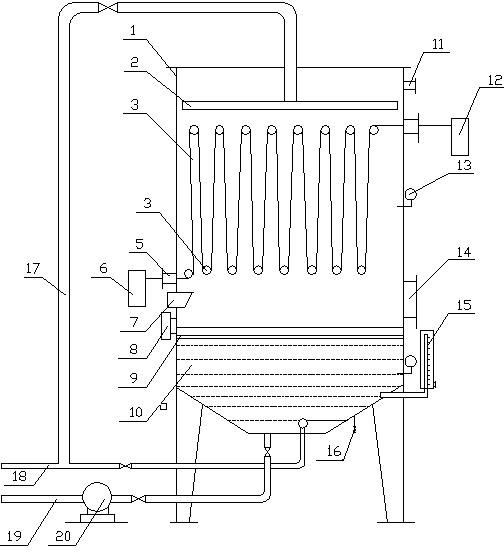Method for producing vinegar by liquid spraying fermentation tower with non-woven fabric filling system
A technology of liquid pouring fermentation and non-woven fabrics, applied in the fields of textiles, microorganisms, food and beverages, and fermentation, can solve the problems of increasing production costs, time-consuming, and the inability of liquid pouring vinegar to be recycled for a long time, so as to save costs. , the effect of improving the unit utilization rate
- Summary
- Abstract
- Description
- Claims
- Application Information
AI Technical Summary
Problems solved by technology
Method used
Image
Examples
Embodiment 1
[0028](1) Liquefaction of raw materials: Take 1000kg of rice, add 1500kg of water, soak for 6 hours, and grind it into slurry by grinding wheel.
[0029] (2) Alcoholic fermentation: Add 3kg of amylase to the slurry, raise the temperature to 92°C, keep it warm for 15 minutes, boil it, and pump it into the alcohol fermentation tank. Add water to adjust the concentration to 9.5°Bé and adjust the temperature to 32°C. Add 2.4 kg of 50,000 units / g of glucoamylase and 2 kg of active dry yeast, mix well, and ferment at 30-34°C for 5 days.
[0030] (3) Plate and frame filter press: the fermented wine mash is filtered through a plate and frame to obtain sake liquid.
[0031] (4) Acetic acid fermentation: add water to the above-mentioned sake liquor to adjust the alcohol content to 6.5% (v / v), insert 800kg of acetic acid bacteria (AS1.41), and spray the filler system made of non-woven fabrics intermittently after sterilization On the top, let the filling material absorb a large amount ...
Embodiment 2
[0043] (1) Raw material liquefaction: take 1000kg of corn, add 1500kg of water, soak for 6 hours, and grind it into slurry by grinding wheel.
[0044] (2) Alcoholic fermentation: Add 3kg of amylase to the slurry, raise the temperature to 92°C, keep it warm for 15 minutes, boil it, and pump it into the alcohol fermentation tank. Add water to adjust the concentration to 9.5°Bé and adjust the temperature to 32°C. Add 2.4 kg of 50,000 units / g of glucoamylase and 2 kg of active dry yeast, mix well, and ferment at 30-34°C for 5 days.
[0045] (3) Plate and frame filter press: the fermented wine mash is filtered through a plate and frame to obtain sake liquor.
[0046] (4) Acetic acid fermentation: add water to the above-mentioned sake liquor to adjust the alcohol content to 6.5% (v / v), insert 800kg of acetic acid bacteria (AS1.41), and spray the filler system made of non-woven fabrics intermittently after sterilization On the top, let the filler absorb a large amount of fermentati...
Embodiment 3
[0051] Different from Example 1, the diameter of the rollers is 0.02 meters, and the distance between the two rollers is 10 meters.
[0052] The non-woven fabric is a glass fiber non-woven fabric with a thickness of 3 mm, and the filling volume is 1 / 20 of the volume of the tower.
PUM
| Property | Measurement | Unit |
|---|---|---|
| Thickness | aaaaa | aaaaa |
Abstract
Description
Claims
Application Information
 Login to View More
Login to View More - R&D
- Intellectual Property
- Life Sciences
- Materials
- Tech Scout
- Unparalleled Data Quality
- Higher Quality Content
- 60% Fewer Hallucinations
Browse by: Latest US Patents, China's latest patents, Technical Efficacy Thesaurus, Application Domain, Technology Topic, Popular Technical Reports.
© 2025 PatSnap. All rights reserved.Legal|Privacy policy|Modern Slavery Act Transparency Statement|Sitemap|About US| Contact US: help@patsnap.com

